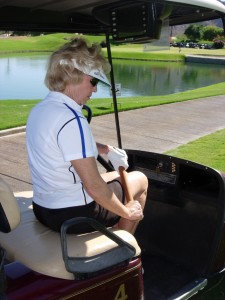by Julie Donnelly – The Pain Relief Expert
Short Leg Syndrome is an interesting term – is your leg really short? Probably not, but the only way to confirm it one way or the other is to have an x-ray of both legs, from your pelvis to your feet. After it is developed, the doctor will measure both legs to see if there is a true anatomical difference in the length of the bones. If there is, you need a lift in your shoes to keep your pelvis and knees level.
What about if the bones are the same length, where does “short leg” have to do with you in that case?I hear it all the time, people will contact me explaining they have been told they have a short leg, and frequently a chiropractor will do an adjustment and suddenly the leg is the right length again.
That’s pretty amazing, especially since bones aren’t able to stretch and shrink. How did the leg get short, and how did it get long again? It’s all related to tightness in two muscles that are key factors to low back pain, hip pain, knee pain, and sciatica – the Psoas and Iliacus muscles.
In the last issue of Pain-Free Living we spoke about these two muscles and the way they pull your lumbar vertebrae and pelvis forward and down, causing low back pain, hip pain, knee pain, and sciatica, and here we are again discussing them and their involvement in short leg syndrome.
Let’s look at the graphic of the two muscles again, but this time we’ll focus on the insertion point on the inside of your thigh bone:
As I mentioned in the last blog, as the two muscles get shorter due to repetitive strain, they will pull your lumbar vertebrae and pelvis forward and down. Visualize the two muscles in this graphic being short and pulling down on the bones, but then visualize you forcing your body to stand erect – what is happening to the bottom of the two muscles, where they insert into your thigh bone (the femur)? They are pulling UP on the bone, causing your leg to appear shorter when you lie down flat and bring your heels together.
Your leg isn’t short, it’s simply pulled up into your trunk. Now, it isn’t pulled up a lot, you aren’t going to limp or anything like that, but your two legs definitely don’t appear to be the same length. To complicate the issue a bit, a muscle called rectus femoris originates on the tip of your pelvis and inserts into your lower leg bone (the tibia). When the rectus femoris contracts normally you straighten your leg from the bent position. However, when your pelvis tilted down it caused the rectus femoris to be too long to do its job, so the body tied a knot at about the midway point of the muscle. This is fine until you try to sit down and the muscle is too short to enable you to bend your knee, so it pulls your pelvis further down to allow your knee to bend.
This is the beginning of a negative “revolving door” each time you sit down (psoas and iliacus shorten) and stand up (rectus femoris shortens).
Here’s an easy treatment to release the spasms in your rectus femoris so your knee can bend and your pelvis isn’t being pulled down in the front.

Using a 12″x1″ length of PVC pipe, press down from the top of your thigh and slide (don’t roll) all the way to just above your knee. If you find tender points, stop and hold the pressure steady for 15-30 seconds before continuing the slide toward your knee. Do this 3-4 times and then stretch.
These two treatments will help you while you’re on the golf course, and it is more beneficial to do the full series of treatments that are demonstrated in The Secret to Your Best Golf Game EVER when you get home. Treating yourself after you play golf will allow your muscles to be stretched, and will heel the muscle fibers.
Wishing you well,
Julie

